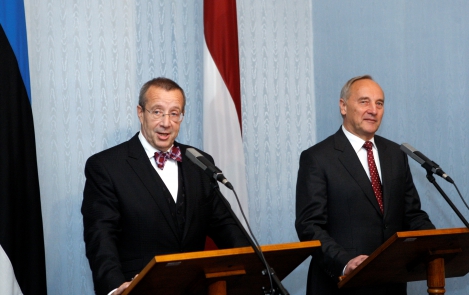-
Reset
+


President Ilves: euros invested into our common infrastructure – this is the benchmark of Baltic co-operation
11.10.2011
“I will never tire from repeating that the future of Estonian-Latvian – and Baltic co-operation in general – is linked to whether and how we understand the importance of common infrastructural and energy projects for the region,” said the President, Toomas Hendrik Ilves, who arrived for a working visit to the Republic of Latvia and met with the Latvian President, Andris Bērziņš, and the Head of Government, Valdis Dombrovskis.
This means, above all, support for Rail Baltica connecting the Baltic states with the rest of Europe and a new nuclear power station in Lithuania, with Estonia, Latvia, Lithuania and Poland all taking part in the project.
“Co-operation between the Baltic states in the 21st century does not involving writing declarations, but rather the initiation and implementation of joint projects – that are useful for us and the European Union in general,” assured the Estonian Head of State. “We have merged with the European Union on a political and economic level; now we need to provide the logistic and energy links and connections.”
According to President Ilves, the responsibility of Estonia, Latvia and Lithuania, both jointly as well as for each other, plays an important role here.
“And to make it all unambiguously clear: for me, the amount of Euros invested into our common infrastructure is the benchmark of Baltic co-operation,” said the Estonian Head of State.
At meetings in Riga, bilateral relations between Estonia and Latvia, which President Ilves described as businesslike and economically important for both parties, were discussed. Latvia is still one of Estonia’s four largest trade partners and Estonia holds, after Sweden, the second place among investors in Latvia, where more than 1,500 companies with Estonian capital are registered.
President Ilves acknowledged cross-border co-operation, which is extending steadily since we joined the Schengen visa space; one of the possible outcomes is to give the population of the border areas of Estonia and Latvia the opportunity to see doctors and get required treatment in both countries by 2013.
The Estonian Head of State encouraged Latvia to move further in joining the euro zone, as: “Our future is certainly closely linked to the European Union, but also the Euro. At the same time, everything indicates that the euro zone is moving towards closer integration and this may result in a rather sad outcome for those who have been left out. It would be very bad if Estonia and Latvia were to remain in different groups of countries, where one is involved in decision-making and the other is not. It would serve both our national interests for Estonia and Latvia to be among the decisions makers.”
When speaking about the European Union Eastern Neighbourhood programme, which is aimed at encouraging greater involvement from the neighbouring countries of the EU, the Estonian Head of State stressed that first of all, these countries must make an unambiguous choice about where they want to belong and what kind of future they choose for themselves.
“It is really simple – are we fellow travellers on European roads or countries that are located close to each other yet take different paths,” President Ilves said. “Should Europe and European values be the choice, the European Union will be willing to support, encourage and assist. But we need to make a choice ourselves that will be followed in future.”
President Ilves also met in Riga with the former Latvian Head of State, Valdis Zatlers.
Latvia is the first country that President Ilves will go to on a working visit, since he gave his oath of office on 10 October in the Estonian parliament.
Office of the President
Public Relations Department
Phone 631 6229




